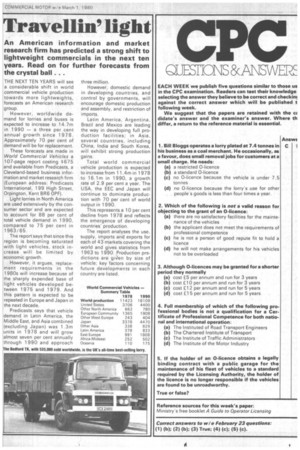Travellin' light
Page 41

If you've noticed an error in this article please click here to report it so we can fix it.
An American information and market research firm has predicted a strong shift to lightweight commercials in the next ten years. Read on for further forecasts from the crystal ball . . .
THE NEXT TEN YEARS will see a considerable shift in world commercial vehicle production towards more lightweights, forecasts an American research group.
However, worldwide demand for lorries and buses is expected to increase to 14.7m in 1990 — a three per cent annual growth since 1978. Approximately 70 per cent of demand will be for replacement.
These forecasts are made in World Commercial Vehicles a 107-page report costing $675 and available from Predicasts, a Cleveland-based business information and market research firm (European address: Predicasts International, 199 High Street, 'Orpington, Kent BR6 OFF).
Light lorries in North America are used extensively by the consumer sector and are expected to account for 88 per cent of total vehicle demand in 1990, compared to 75 per cent in 1963/65.
The report says that since this region is becoming saturated with light vehicles, stock increase will be limited by economic growth.
However„ it argues. replacement requirements in the 1980s will increase because of the sharply expended base of light vehicles developed between 1975 and 1979. And this pattern is expected to be repeated in Europe and Japan in the next decade.
Predicasts says that vehicle demand in Latin America, the Middle East, and Asia combined (excluding Japan) was 1.3m units in 1978 and will grow almost seven per cent annually through 1990 and approach three million.
However, domestic demand in developing countries, and control by governments, will encourage domestic production and assembly, and restriction of imports.
Latin America, Argentina,. Brazil and Mexico are leading the way in developing full production facilities; in Asia, several countries, including China, India and South Korea, will exhibit strong production gains.
Total world commercial vehicle production is expected to increase from 11.4m in 1978 to 16.1m in 1990, a growth rate of 2.9 per cent a year. The USA, the EEC and Japan will continue to dominate production with 70 per cent of world output in 1990.
This represents a 10 per cent decline from 1978 and reflects the emergence of developing countries' production.
The report analyses the use, supply, imports and exports for each of 43 markets covering the world and gives statistics from 1963 to 1990. Production predictions• are gien by size of vehicle; key factors concerning future developments in each country are listed.
















































































































